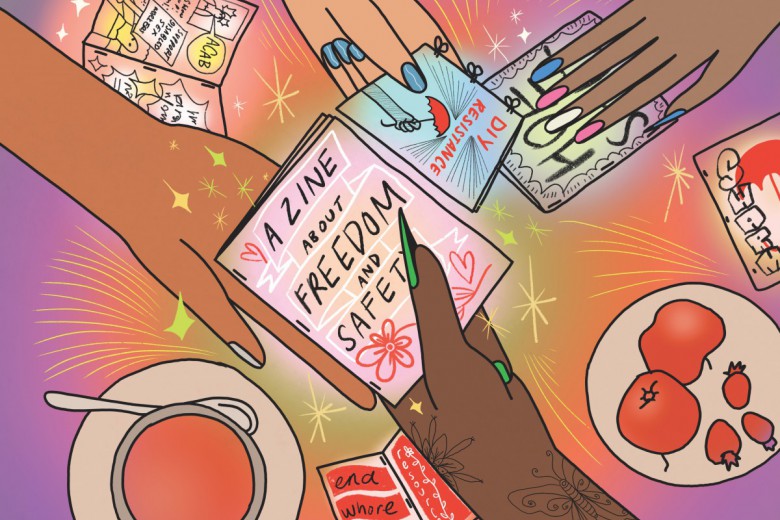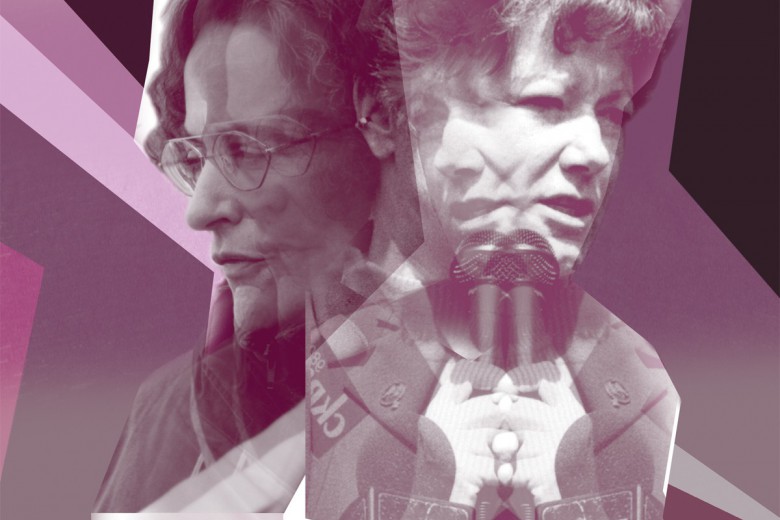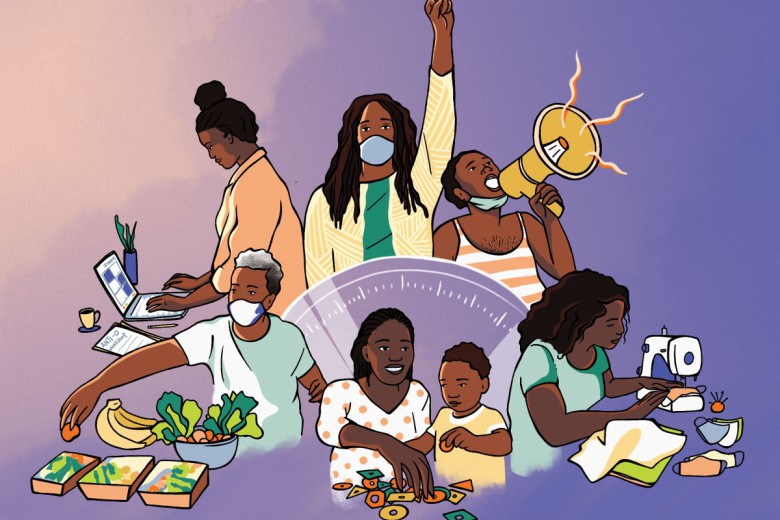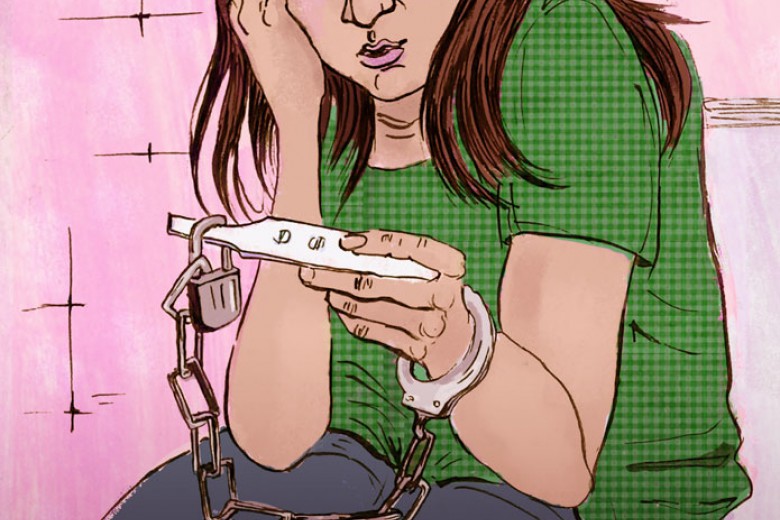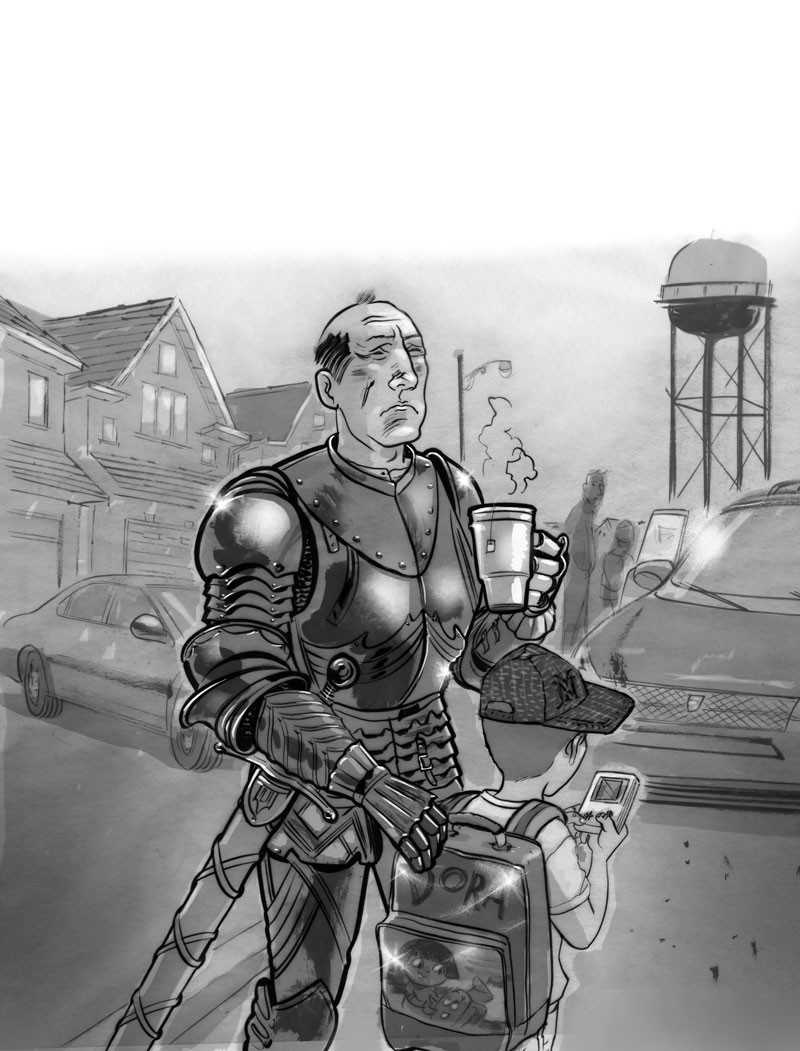
I first heard about fathers’ rights groups when I was working at a Vancouver drop-in centre for women several years ago. A family law advocate for a similar organization in a neighbouring community told me about a group of men who would show up at court in matching T-shirts to support male members of their organization who were engaged in custody and access disputes with their ex-partners. The groups would do this to try to influence the judges and intimidate the women, who were often there without a lawyer or any other support besides the advocate. Concerned, I wondered how organized these men were and if it was a local phenomenon. To my surprise, I learned that this group was part of a global movement with a membership ranging from Caribbean Canadian Senator Anne Cools to British anti-poverty activist Bob Geldof (though the vast majority of fathers’ rights leaders and activists are white, middle-class, conservative men).
There is a diversity of thought and tactics to fathers’ rights groups, but they share a focus on issues of family law – in particular, issues surrounding custody and access to children. Organizations like Fathers 4 Justice, Fathers are Capable Too, Canadian Equal Parenting Council, Dads Canada and Equal Parenting BC have adopted the language of “equal rights” and resistance to oppression, but wield these terms in defence of traditional ideas of fatherhood and male privilege.
Although fathers’ rights groups have existed in Canada since the 1970s, it wasn’t until the mid-1990s that they began to emerge as an influential voice in divorce and child custody proceedings. In 1998 a Special Joint Committee on Child Custody and Access was convened to consult with individuals and communities across Canada on proposed changes to the Divorce Act. This committee included allies of the fathers’ rights movement such as Senator Anne Cools and committee co-chair Roger Galloway, then a Liberal MP for Sarnia Lambton. Although this consultation process was widely considered a failure (the resulting report was not adopted by the Justice Minister and none of the recommendations of the committee were adopted), it did highlight how family law has become the staging ground for a heated struggle around gender norms in modern families. With strong support from within the committee, the consultation process became a platform for fathers’ groups to air their grievances with the current system. In particular they called for “equal shared parenting” and increasing non-custodial parents’ rights.
In Canadian law there are two forms of equality that are commonly discussed, formal equality and substantive equality. A strict “formal equality” approach demands that everyone is treated exactly the same regardless of mitigating circumstances. At first glance, this approach sounds reasonable as it would allow a father’s grievance in the courts to be given equal airing to that of the mother. However, this “gender neutral” approach obscures the substantially different ways the men and women experience separation, divorce and the justice system.
While experiences of divorce and separation vary, many women find that the end of a relationship means a new life of precarity, lower income (if not complete loss of income) and single motherhood. While poverty rates among women before divorce are 16 per cent, after divorce these rates increase dramatically to 43 per cent. This drop in socio-economic status coupled with decreases in government support for family law legal aid in many areas of Canada means that women are often unable to access adequate legal representation or advice in family law matters like custody and access.
This situation is especially serious for women who are leaving abusive relationships, disabled women and newcomers who face barriers to accessing the legal system due to limited English language skills and unfamiliarity with our legal institutions. Not having access to legal advice means that these women are less likely to be able to present their arguments within legal language, and are therefore less likely to be taken seriously by the judge or mediator.
This is where substantive equality comes in. Substantive equality accounts for these patterns of discrimination and oppression in an effort to guarantee equality not just of opportunity but of outcomes. Basically, substantive equality recognizes that we don’t all start at the same place due to structures of privilege and oppression, and stipulates that giving everyone a fair chance requires that we compensate for these imbalances.
The two approaches to equality can be effectively contrasted using the example of sharing an apple with a friend. While formal equality would require splitting the apple 50/50, addressing substantive equality requires that we ask what both individuals had eaten that day and divides the apple based on need (or in this case hunger). A substantive equality argument in the case of custody and access would recognize the disproportionate burden women carry in child rearing, as well as the lack of equity many women face in the workplace.
When fathers’ rights groups speak of equality, they rely heavily on conceptions of formal equality that obscure the unequal relationships between men and women in a patriarchal society. For instance, in a document prepared by the Canadian Equal Parenting Council, equal parenting is defined as “the presumption that both parents should share responsibilities and time on the basis of equal rights. Of course parents may agree to divide duties … but if they can’t agree, such as in highly-conflicted divorce, both parents keep equal rights and responsibilities.”
Using a substantive equality lens, however, we must ask whether the presumption of shared responsibilities reflects the realities of families in Canada today. Statistics show that for most families today parenting is neither equal nor shared. Therefore, any discussion of responsibilities and rights must take into account women’s disproportionate burden in caring for children.
In 2004, for instance, over 14,000 women in Canada left their paid employment due to unpaid caregiving responsibilities – double the number of men – and missed an average of 10 days of work due to caregiving commitments, while men missed, on average, a day and a half. According to Statistics Canada, men have increased their participation in unpaid work in the household in the last ten years from an average of 2.1 to 2.5 hours a day. This change corresponds with a half hour decrease in women’s household labour, moving from 4.8 hours daily in 1996 to 4.3 hours in 2006. It is clear that households are changing but it is equally clear that we are a long way off of a 50/50 split in household labour.
The reality of separation in Canada today is that even when joint-custody arrangements are made, children are typically cared for primarily by the mother, while decision-making is shared by both parents. In practice, this emphasis on shared parenting and increased non-custodial parents’ rights only serves to reinforce the roles demanded of the traditional heterosexual nuclear family, with the father as the decision-maker and the mother as the primary source of unpaid reproductive labour in the form of child care, food preparation and cleaning.
In order to appease the strong local fathers’ rights movements, England and Australia have shifted away from the framework of custody and access to a shared parenting model, where each parent keeps their pre-separation roles and responsibilities. However, this shift just further perpetuates unequal relationships. A study undertaken in Australia three years after the amendments were introduced found that the changes had put an increased pressure on women to provide contact even in situations that compromised their safety. Additional studies found that the changes had not reduced conflict or litigation, nor had they substantially changed caregiving patterns. Shared parenting models, the evidence suggests, simply do not address the root problems of gendered inequality that shape women’s experience both before and after separation.
Nonetheless, members of the Conservative Party have supported further entrenching patriarchal relations through similar changes to family law. The Conservative Party has included a commitment to shared parenting after separation in various election platforms. Last year, former MP Carol Skelton and sitting Saskatchewan MPs Maurice Vellacott and David Anderson (all Conservatives) publicly pledged support to equal shared parenting in the House of Commons. Fathers 4 Justice activists continue to rally support in British Columbia and across Canada, staging banner drops off of prominent bridges while dressed as superheroes and trekking across Canada to raise awareness and money. Fathers’ rights groups have also worked together with the conservative women’s organization REAL Women to lobby for equal shared parenting. Beyond extensive lobbying and direct action tactics borrowed from social justice organizations, fathers’ rights groups have also attempted to simply bully groups into supporting their cause. Bruce Wood of the Saskatoon Men’s Resource Centre, a male-positive, pro-feminist, gay-affirmative and anti-racist non-profit organization, told Briarpatch that the Centre “has been the target of an organized campaign of harassment by fathers’ rights activists in Saskatchewan and Alberta.” The Centre, Wood said, has been “flooded” with anonymous calls, voice mail messages and emails – many of which appear to have been scripted – voicing anger at everything from the courts to women’s violence against men.
“The objective of their harassment is to confront us on our public support of the feminist movement and our work on male violence against women,” Wood said. “They also have insisted that we take a public stand in favour of something they call “˜equal shared parenting.’”
These tactics have put many feminist and pro-feminist organizations further on the defensive as they seek to maintain services at a time of funding cuts and increased demand for services. Without an infusion of new volunteers, the Saskatoon Men’s Resource Centre is at risk of having to scale back its programming. Likewise, many feminist women’s organizations have borne the brunt of cutbacks. In Vancouver, 100 per cent of the North Shore Women’s Centre’s operational funding from the provincial government was cut in 2002 and the centre has only been able to keep its doors open through community support and fundraising. In the midst of these financial struggles, the North Shore Women’s Centre has struggled to block a local fathers’ rights organization from joining a local Coordinating Committee on Violence Against Women in Intimate Relationships. The committee had been alerted to the presence of the fathers’ rights activists when they lobbied to change the language in the District of North Vancouver’s violence policy to remove any mention of gender. Michelle Dodds of the North Shore Women’s Centre told Briarpatch, “we spent a lot of time trying to figure out if they were going to come to community meetings. If we thought they were going to present at a meeting, we had to prepare people so that they would understand what it was that they were saying.”
Although the committee was able to block the group from joining, they have increasingly had to devote already strained resources to providing services not just to abused women but also to men stirred up by the angry rhetoric of the support groups organized by the local fathers’ rights centre. These support groups have been effective at capitalizing on men’s feelings of loss after separation. Playing to traditional conceptions of male authority and entitlement, these groups build upon and stoke men’s sense of victimization, scapegoating their former spouses, feminists and the courts for the failure of their relationships.
One man in North Vancouver described to a community advocate how attending fathers’ rights support group meetings caused him to develop an anger he never had before he attended the meetings. Feminist and pro-feminist organizations have had to devote increasing energy to countering these myths of victimization and to supporting men to take responsibility for their role in the failure of the relationship. According to Bruce Wood, “there are lots of men (as there are women) who are full of grief, anger, sadness and shock after a relationship comes to an end. These men deserve to be heard and to be helped heal – not to have their anger fed like a fire for political lobbying purposes.” In a past Briarpatch article (March/April 2007), Wood asserts that “heterosexual men seeking connection with and support from other men have proven easy targets for … fathers’ rights organizations.” Wood goes on to suggest that our “unwillingness to support and deliver comprehensive education for adult men … is a significant contributing factor in our failure to reduce the rate of violence against women.”
The challenge for the feminist movement is to engage men in the discussion around the relationship between fatherhood and masculinity. We must engage in these discussions not only for men but also for women, who bear the brunt of abuse and are facing a disproportionate burden in caregiving that impacts their economic freedom before and after separation.
Fathers’ rights groups have proven very effective at reaching out to and supporting men who are anxious about their perceived loss of power in a relationship that is dissolving, turning that anxiety into anger, and directing that anger outward at spouses, women in general, and the courts. They have been equally proficient at taking equality language that was originally developed out of social justice movements and using it to support traditional ideas of masculinity.
Activists need to re-engage with and support feminist and pro-feminist organizations in our community, reclaim the language of substantive equality, and contribute to rebuilding a national feminist movement to counter the fathers’ rights movement and push for real equality pre- and post-separation.
Challenging the myths of the fathers’ rights movement
Myth #1 – Men face a disproportionate burden when paying child support
In 1997, the federal government brought forward child support guidelines to regulate the amount that non-residential parents are obligated to pay to support their children. Prior to the regulations being introduced, recipients of child support saw their income go down by 29 per cent after divorce and the income of the payers increased 20 per cent. Clearly there was a need to balance the situation.
These new guidelines calculated payments according to income and the number of children, and have helped set a common standard across Canada that had not previously existed. That same year, the tax law was changed so that child support payments were no longer tax deductible by the payee. For many men, these policy changes represented an increase in the support they were expected to pay. The fathers’ rights group Fathers Are Capable Too characterized the regulations as “arbitrary, greedy and [an] inaccurate formulation by people who knew better.”
But according to the courts, child support is the right of the child and in their view it is the right of children to enjoy a standard of living similar to that of the non-residential parent.
Myth #2 – Men face a women-friendly bias when applying for custody
There has been a dramatic shift over the past several years towards joint custody. Joint custody in Canada allows for a child to spend similar amounts of time with each parent and requires shared decision-making. Usually there is a primary parent and generous access for the non-residential parent, with major decisions like where the child attends school made by both parents. The difference between joint custody and equal shared parenting is that joint custody is awarded on a case-by-case basis and the decision is made based on the best interests of the child. In 2004, just under half of all custody cases were granted jointly; this number roughly equalled the number of cases where custody was given to the wife only. Sole custody was given to the father in only eight per cent of the cases that year. This has led fathers’ rights groups to argue that women receive custody whenever they ask for it and men almost never receive custody. However, given that decision-making and access to children is shared in almost half of all custody and access cases, it can hardly be said, as Fathers for Justice does on their website, that “family law has evolved from being anti-female to anti-male … the pendulum has swung too far.”
In his paper “Hard Time to be a Father: Reassessing the Relationship Between Law, Policy and Family,” Richard Collier, a British legal theorist on men and family law, challenges the assumption that custody should be 50/50 between men and women, arguing that it devalues the ongoing work of women in caring for children. Collier questions the courts’ emphasis on shifting parenting practices after the relationship has broken down and instead calls for men to be accountable for their parenting practices during relationships. According to Statistics Canada, men currently do not contribute 50 per cent of the labour of raising a child and make few of the career sacrifices, so joint custody represents a substantial shift in parenting dynamics. Contrary to the myth of a women-friendly court system, it seems that the courts are giving men the benefit of the doubt in awarding joint-custody in such large numbers.
A disturbing reality is that the likelihood of sole custody being given to the father may increase if the mother alleged that the father was abusive to her or the children during the course of their relationship. In survey of 100 self-identified protective parents by researchers at California State University, 94 per cent identified that they were the primary parent in the relationship prior to separation and 87 per cent had custody at the time of separation. However, after reporting child abuse only 27 per cent of the mothers were left with custody after the resulting court proceedings. Forty-five per cent of the mothers were labelled as causing “Parental Alienation Syndrome” in their children. (See below for a discussion of Parental Alienation Syndrome.)
Myth #3 – Women often make up stories of abuse to discredit the other parent’s custody bid
The fathers’ rights movement alleges that women lie to the courts and make up stories of abuse to “get back” at the father. Groups like Fathers are Capable Too argue that Parental Alienation Syndrome, a supposed condition with no scientific foundation, is a disorder that results from the dysfunctional and adversarial divorce system.
Only five per cent of separation and divorce cases end up as “high conflict” cases where parents are not able to come to a mutual agreement on custody, access and child support, but instead go to trial. High-conflict family law cases are often characterized by a history of violence within the family. If they acknowledge such violence, fathers’ rights activists characterize these cases as instances of men driven to violence over the stress of the legal battle, lashing out in anger at spouses who have unfairly denied their access to their children. However, many fathers’ rights sites don’t even bother to justify violence as they simply deny it exists, claiming that women unfairly and inaccurately fabricate stories of abuse in order to separate the children from their father.
This narrative of embittered women lashing out at helpless fathers through the children represents one of the main areas of pseudo-science that has emerged from the father’s rights movement: Parental Alienation Syndrome. Parental Alienation Syndrome was “discovered” by the late Dr. Richard Gardner in 1985 while he was working as a paid consultant to men charged with sexually abusing their children. Gardner defined Parental Alienation Syndrome as “a disorder that arises primarily in the context of child custody disputes.” He claimed that “it results from a combination of a programming (brainwashing) parent’s indoctrinations and the child’s own contributions to the vilification of the target parent.”
Gardner often dismissed claims of abuse voiced by children as merely symptoms of parental alienation, where one parent (typically the mother) has turned the children against the other parent.
Critics of Gardner’s work, and there are many, have highlighted that Parental Alienation Syndrome fails to account for the multiple factors potentially contributing to a child’s rejection of a parent, thus grossly oversimplifying a complex situation. Gardner justifies this simplification based on a very constrictive definition of how “real” sexually abused children behave. If an abused child does not behave in the narrow manner that Gardner proposes, he assumes no abuse has taken place. Thus, Parental Alienation Syndrome’s assessment procedures rely on a circular logic that almost guarantees the conclusion that a given child has the syndrome.
In Canada, two Queen’s University law professors, Nicholas Bala and John Schuman, reviewed 196 judges’ decisions between 1990 and 1998 where allegations of physical and sexual abuse were made in the context of separation in order to determine what patterns emerged. They found that judges concluded that only a third of all false allegations were a result of individuals deliberately lying in court. Moreover, the study found that men were far more likely to make intentionally false allegations of abuse, as 21 per cent of men brought forward intentionally false allegations compared to only 1.3 per cent of women.


